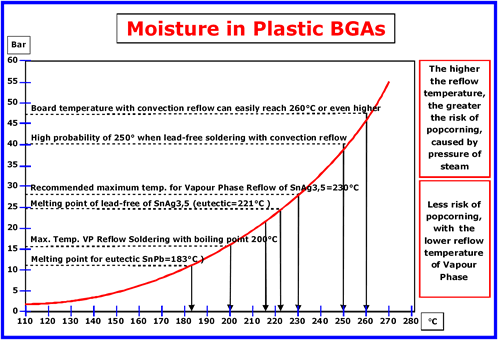 |
|
|
|
|
 |
|
|
|
|
|
|
|
|
|
|
|
|
|
|
|
|
|
|
|
|
| Vapour Phase Reflow - Heat Transfer onto BGA's |
 Plastics are hygroscopic. Therefore humidity is absorbed into the body of the BGA. With reflow soldering this can lead to high pressure rates of the encapsulated water. This can cause delamination of the substrate, called "popcorning". As temperatures rise above 210°C the situation becomes more critical. |
 The most critical point is that popcorning is not easily detected since it happens below the BGA. With Vapour Phase soldering the risk of popcorning is minimised. |
 |
| Vapour
Phase Reflow: Space under BGA easily reached by condensing vapour phase. Minimal danger of popcorn effect. Heat transfer through different/various layers of material The solder joints of a BGA are mostly hidden, It is therefore difficult to apply direct heat transfer. Heating of BGA solder joints relies heavily on layers of material with good and bad heat conductivity. Layers with good heat conduction quickly heat to the centre. Good heat conduction means good heat loss too. The added heat flows to other parts of the PCB to create a thermal balance (even temperature throughout). The quality of the heat transfer from both sides of the PCB has a great influence on solder joint heating. The best possible and most easily controlled heat transfer is given by vapour phase reflow soldering through the condensing vapour. Heat transfer in Reflow-soldering Starts from the outside and works its way inwards. This can be seen as concentric circles. The middle ball is usually the last to melt. Problems with BGA soldering Popcorn effect – moisture Damp/Humidity diffuses through the liquid mass onto the chip. Moisture caused by the tapped water can cause popcorning underneath the BGA, which can cause delamination of the substrate. The main problem with popcorning is that it occurs underneath the BGA and cannot be seen immediately. Vapour Phase soldering minimises this possible defect considerably. |